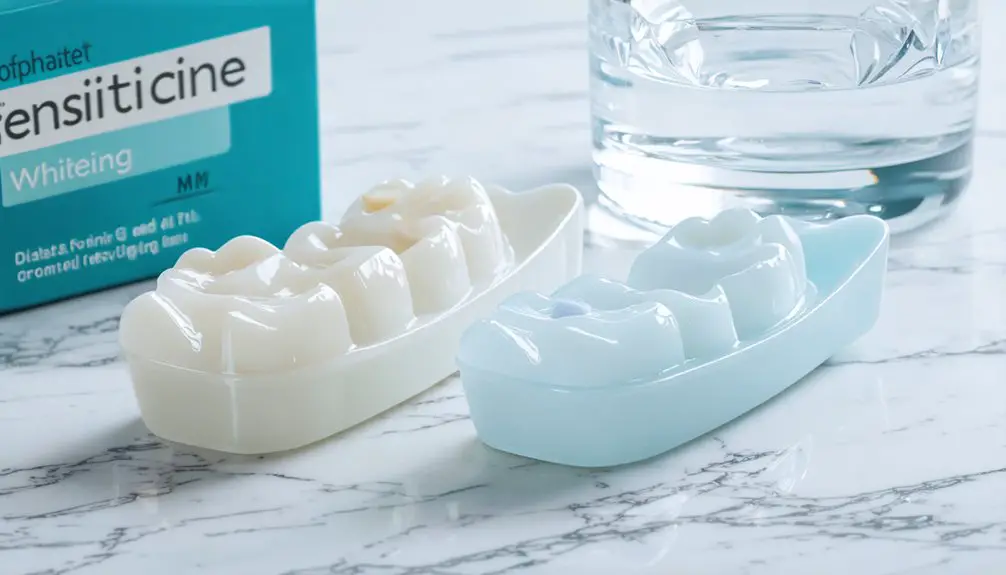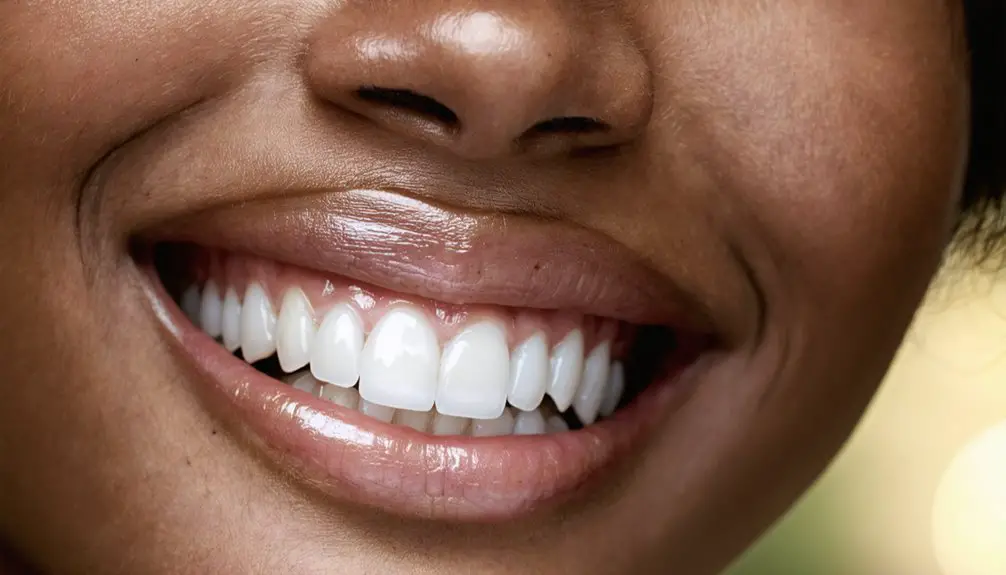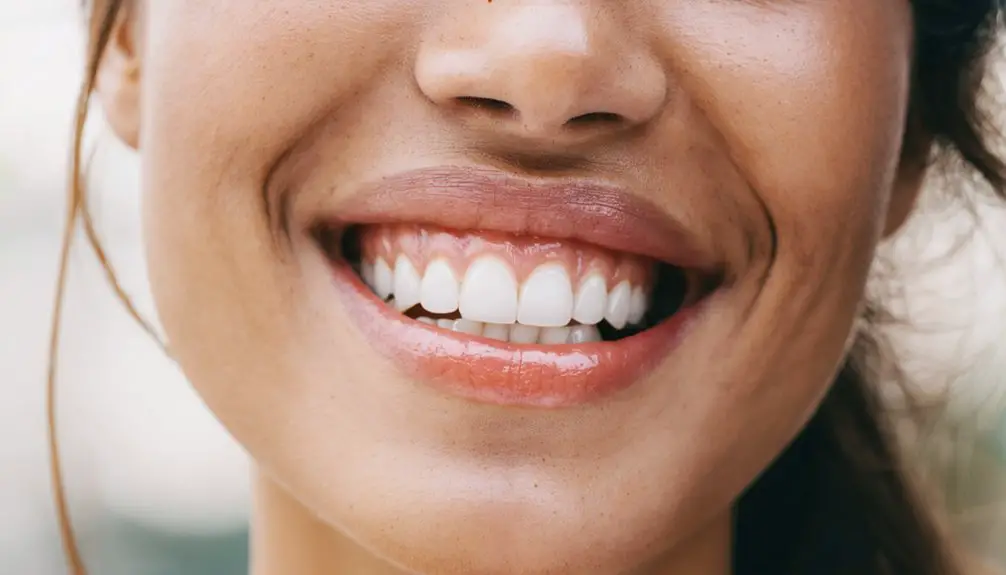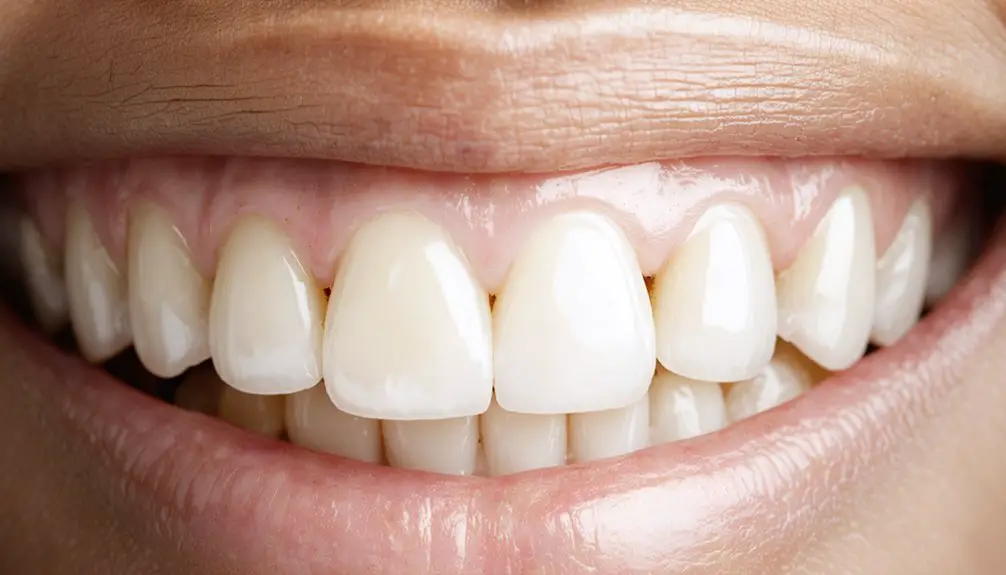Teeth whitening can dramatically improve your smile through a safe oxidation process that breaks down stain molecules in your enamel. You’ll benefit from increased confidence and enhanced social perception, with 85% of patients reporting improved self-image after treatment. Whether you choose professional treatments offering up to 8 shades lighter in one session or at-home options for gradual results, modern whitening technologies provide predictable, lasting outcomes. Discover how advanced techniques can transform your smile while protecting your dental health.
Key Takeaways
- Professional teeth whitening can brighten teeth up to 10 shades lighter, with results lasting up to three years with proper maintenance.
- 85% of patients report improved self-image after teeth whitening, leading to increased social confidence and better interpersonal relationships.
- Teeth whitening can positively impact job interviews and career advancement by enhancing personal branding and professional appearance.
- Modern treatments are safe under professional supervision, with minimal enamel damage and manageable sensitivity issues.
- Both professional and at-home options are available at different price points, making teeth whitening accessible to various budgets.
The Science Behind Teeth Whitening
The science of teeth whitening revolves around a sophisticated oxidation process that systematically breaks down stain molecules within your teeth’s structure.
When you apply bleaching agents containing hydrogen peroxide or carbamide peroxide, they penetrate your enamel and dentin layers within 5-15 minutes. These agents release oxygen molecules that target and dismantle the chemical bonds responsible for discoloration.
The oxidation process continues working in your teeth for up to two weeks after treatment, as oxygen remains active within the dental tissues. During this time, the bleaching agents work through multiple pathways, including dentinal tubules, to reach deeply embedded stains. For optimal results, maintaining proper pH balance during treatment helps prevent enamel demineralization and ensures safe whitening.
Modern treatments often incorporate light activation through UV, LED, or laser technology to accelerate this process, making your whitening treatment more efficient and effective. While extrinsic stains on the enamel surface are typically easier to remove, the process can also address deeper discoloration.
Professional vs. At-Home Treatment Options
When deciding between professional and at-home teeth whitening options, you’ll encounter significant differences in treatment strength, speed, and effectiveness.
Professional techniques utilize high-concentration peroxide (25-40%), delivering dramatic results of up to 8 shades lighter in just one session under expert supervision. These treatments typically last longer and provide more predictable outcomes. A consultation with a dentist ensures safer whitening treatment by identifying potential oral health issues beforehand. Age-related discoloration occurs as our teeth naturally reveal yellow dentin underneath thinning enamel.
At-home solutions offer greater convenience and affordability, using lower peroxide concentrations (3-10%) that gradually whiten teeth over weeks. While they’re gentler on your budget at around $50 compared to $300+ for professional services, they require consistent application and longer treatment periods.
Your choice should depend on your desired timeline, budget, and whitening goals. Professional treatments excel for immediate results, while at-home options work well for gradual improvement and maintenance.
Immediate and Long-Term Benefits
Your teeth’s whitened appearance can boost social confidence immediately after treatment, especially following professional in-office sessions that deliver visible results in a single visit.
At-home treatments require about two weeks of consistent use but offer similarly lasting benefits, with proper maintenance extending results up to 6 months or longer. Hydrogen peroxide treatments at professional offices provide the most dramatic whitening effects in the shortest time. Results may vary depending on the type of discoloration, as yellowish stains tend to respond better to whitening treatments than gray or brown ones.
Professional whitening’s dramatic improvements to your smile can enhance both personal and professional interactions, potentially leading to better oral hygiene habits and sustained psychological benefits.
Enhanced Social Confidence
Achieving whiter teeth through professional treatments or at-home products can dramatically boost social confidence and self-esteem, with studies showing that 85% of patients report notable improvements in their self-image after whitening.
You’ll experience enhanced social perception and personal branding as you engage more confidently in face-to-face interactions, feeling less self-conscious about your smile. The release of endorphins during smiling creates a natural mood elevation that reinforces positive social interactions.
Research indicates that whitening reduces feelings of social anxiety and promotes better interpersonal relationships, with 90% of patients reporting increased security in social situations. Middle-aged adults show the highest interest in pursuing teeth whitening treatments.
The psychological benefits persist long-term, often lasting a year or more after treatment.
You’ll likely find yourself more willing to participate in social events, while maintaining improved oral hygiene habits that sustain both dental health and newfound confidence.
Quick Visible Results
Beyond the social confidence boost, teeth whitening delivers rapid and measurable changes to your smile.
Professional in-office treatments can lighten your teeth by up to 10 shades in just 30-60 minutes, with immediate effects visible as soon as you leave the dental chair. Using high-concentration peroxide gels, these treatments provide dramatic visible change that continues to develop over the next 24-48 hours. Systems like Zoom® Whitening can achieve shade improvements of 7-8 levels.
With up to 90% success rates reported for teeth whitening treatments, you can feel confident investing in this cosmetic procedure. You’ll enjoy these brightening results for several months to three years, depending on your lifestyle habits.
While at-home treatments require longer treatment periods, they offer comparable long-term outcomes. To maximize your results, maintain good oral hygiene and minimize consumption of staining substances.
For best outcomes, consider a hybrid approach combining professional treatment with take-home maintenance kits, ensuring both immediate and sustained whitening benefits.
Lasting Professional Impact
Professional teeth whitening delivers both immediate and enduring benefits that surpass typical over-the-counter solutions.
You’ll experience lasting effects that can brighten your smile by up to 10 shades and maintain results for up to three years with proper care. The professional benefits extend beyond aesthetics, as treatments are performed in controlled environments with customized plans that protect your oral health.
- Clinical-grade treatments provide deeper stain removal while preserving enamel integrity through protective agents and fluoride applications.
- Supervised procedures minimize sensitivity risks and include thorough oral health evaluations.
- Long-term psychological and social advantages include enhanced self-confidence, improved professional opportunities, and more positive social interactions.
These lasting professional impacts make teeth whitening a worthwhile investment in both your oral health and personal well-being.
Safety Considerations and Side Effects

While teeth whitening is generally safe, you’ll need to be aware of common side effects like tooth sensitivity and gum irritation that affect up to 67% and 50% of patients respectively.
You can minimize these risks by following proper application protocols, using lower peroxide concentrations, and avoiding excessive treatments that could potentially damage your enamel.
Professional treatments under dental supervision typically offer better safety profiles than DIY methods, particularly in preventing uneven results and soft tissue exposure to bleaching agents.
Common Side Effects
Despite their widespread use and effectiveness, teeth whitening treatments can produce several common side effects that users should understand before beginning treatment.
You’ll likely encounter some temporary discomfort, which varies depending on the treatment concentration and your individual sensitivity.
The most frequently reported side effects include:
- Teeth sensitivity affecting 30-78% of patients, particularly during treatment and up to two weeks after
- Gum irritation manifesting as redness or burning sensation, especially with ill-fitting trays
- Uneven results or color mismatches, particularly with over-the-counter products
Higher peroxide concentrations typically cause more intense side effects.
While most symptoms resolve within days of stopping treatment, about 14% of users may need to discontinue treatment due to severe sensitivity.
You’ll want to take these factors into account when choosing your whitening method.
Minimizing Treatment Risks
Understanding these side effects leads us to explore specific ways to minimize treatment risks during teeth whitening procedures. To protect your dental health, choose products with lower peroxide concentrations, around 10% carbamide peroxide, which notably reduces sensitivity while maintaining effectiveness.
You’ll want to follow strict safety protocols, including proper tray fitting and precise gel application to prevent soft tissue exposure.
Consider using oral care products containing hydroxyapatite or potassium nitrate to combat sensitivity through remineralization. If you have preexisting conditions like gingival recession, work with a dental professional to develop appropriate risk management strategies.
They’ll monitor treatment duration and concentration levels to protect your tooth structure while achieving desired results. Professional supervision guarantees proper technique and helps prevent chemical burns, tissue damage, and other adverse effects.
Professional Vs DIY Safety
Because safety protocols differ greatly between professional and DIY teeth whitening treatments, you’ll find distinct risk profiles for each approach.
Professional supervision guarantees controlled peroxide concentrations, precise application techniques, and customized treatment plans that greatly reduce risks of sensitivity and gum irritation.
Key safety differences between professional and DIY whitening include:
- Professional treatments incorporate desensitizing agents and protective measures, with studies showing minimal enamel damage under proper supervision.
- DIY products contain lower peroxide concentrations but risk improper application, leading to uneven results or soft tissue irritation.
- Professional monitoring allows immediate adjustment of treatment protocols if sensitivity occurs, while DIY approaches may continue causing discomfort.
Choose ADA-approved products if opting for DIY whitening, but consider professional treatment for best safety and effectiveness, especially if you have existing dental work or sensitivity concerns.
Boost Your Confidence and Social Life

The transformative power of teeth whitening extends far beyond cosmetic changes, creating profound impacts on psychological well-being and social dynamics.
Teeth whitening transcends mere appearance, reshaping how we feel about ourselves and interact with the world around us.
Current whitening trends indicate that a brighter smile can greatly boost your self-confidence and reduce social anxiety. You’ll likely find yourself smiling more freely, leading to improved interpersonal connections and communication.
Social perceptions of whiter teeth often translate into tangible benefits in your personal and professional life. Research shows that a brighter smile can enhance your prospects during job interviews, public speaking engagements, and dating scenarios.
With about 48% of U.S. adults pursuing whitening treatments, you’ll join a growing number of individuals who recognize the value of dental aesthetics in building stronger relationships and advancing career opportunities.
Understanding Different Whitening Methods
When exploring teeth whitening options, you’ll encounter several distinct methods that vary greatly in their approach, effectiveness, and application.
A whitening techniques comparison reveals professional in-office treatments deliver the most dramatic results, using 25-40% peroxide concentrations under careful supervision.
At-home efficacy varies markedly based on the method chosen.
Here’s what you need to know about the main approaches:
- Professional treatments: LED, laser, or Zoom whitening can lighten teeth up to 8 shades in 90 minutes
- At-home systems: Strips, trays, and gels use 3-10% peroxide for gradual improvement of 3-6 shades
- Maintenance options: Whitening toothpaste and rinses provide minimal but consistent results for ongoing care
Each method offers unique benefits, allowing you to choose the approach that best serves your patients’ needs and lifestyle requirements.
Maintaining Your Bright Smile

Maintaining your newly whitened smile requires consistent dedication to proper oral hygiene and lifestyle modifications.
A bright, white smile isn’t just about the treatment – it’s about committing to healthy habits that preserve those pearly whites.
You’ll need to brush twice daily with a soft-bristled brush, floss regularly, and use whitening toothpaste strategically to protect your investment.
Your dietary considerations should include limiting staining substances like coffee, tea, and red wine.
When consuming colored beverages, use a straw to minimize contact with your teeth.
Your lifestyle habits greatly impact whitening longevity – quit smoking and stay hydrated with plain water.
For professional maintenance, schedule regular dental cleanings and consult your dentist about touch-up treatments.
Remember protective measures, especially during the critical 48-hour window post-treatment when your enamel is most vulnerable.
Avoid staining agents during this period to guarantee ideal, long-lasting results.
Treatment Duration and Expected Results
Selecting an appropriate teeth whitening treatment requires understanding the time commitment and expected outcomes for different options.
Treatment efficiency varies considerably between in-office and at-home methods, with professional treatments taking 30-90 minutes versus home kits requiring 14 days of twice-daily applications.
Results longevity depends on your habits and enamel characteristics, but you can expect:
- In-office whitening results lasting 6 months to 2 years
- At-home kit results lasting several months with regular touch-ups
- Combined treatment approaches maintaining brightness for 6+ months
Your lifestyle choices directly impact how long your results will last. Avoiding staining agents like coffee, wine, and tobacco helps maintain whiteness for up to a year.
For ideal outcomes, consider your initial tooth color and existing dental work when choosing between treatment options.
Cost Analysis and Value Comparison
A thorough cost analysis of teeth whitening options reveals significant price variations across treatment methods, from professional services to DIY solutions.
You’ll find professional in-office treatments ranging from $350 to $1,500, offering the most dramatic results that can last up to three years. While this may seem expensive initially, the cost effectiveness becomes apparent when considering the longevity of results.
Dentist-provided take-home kits present a middle-ground pricing strategy at $300-$600, delivering reliable results for 6-12 months.
Over-the-counter products ($5-$50) and DIY methods (under $20) offer more affordable alternatives but require frequent reapplication.
When evaluating options, consider that professional treatments’ higher upfront costs often translate to better value long-term, particularly in urban areas where prices can be 15-30% higher.
Latest Innovations in Teeth Whitening
You’ll find remarkable advancements in teeth whitening through smart technologies that combine AI-enhanced light activation systems with personalized treatment protocols.
Natural whitening innovations now incorporate plant-based agents and biocompatible compounds like PAP, offering effective results without the sensitivity concerns of traditional peroxide treatments.
Light-activated professional treatments have evolved to include sophisticated LED and laser systems that maximize whitening power while protecting your enamel through automated intensity adjustments.
Smart Whitening Technology Evolution
Recent advancements in teeth whitening technology have revolutionized cosmetic dentistry, introducing sophisticated solutions that combine laser treatments, LED activation, nanotechnology, and artificial intelligence.
Smart technology now offers you personalized whitening experiences with enhanced precision and efficiency.
Today’s whitening advancements deliver superior results through:
- AI-driven customization that creates tailored protocols based on your unique dental profile
- Laser systems that provide targeted treatment with minimal impact on surrounding tissues
- LED technology that activates whitening agents up to 40% faster while reducing sensitivity
These innovations guarantee you’ll receive treatment that’s not only more effective but also more comfortable than traditional methods.
With nanotechnology integration and machine learning algorithms optimizing your treatment, you can achieve professional-grade results with unprecedented precision.
Natural Whitening Breakthrough Products
Breakthrough innovations in natural teeth whitening have transformed the traditional approach to dental aesthetics, introducing sophisticated solutions that prioritize both effectiveness and safety.
You’ll find eco-friendly solutions like PAP-based whitening agents that effectively remove stains without the harsh effects of peroxide. These natural alternatives protect your enamel while delivering professional-grade results.
Advanced formulations now incorporate nano-hydroxyapatite particles, offering dual benefits of whitening and remineralization.
You’re getting gentler treatment options that won’t compromise your dental health. With enzyme-based bleaching agents and biocompatible compounds, you can achieve brighter smiles while maintaining tooth integrity.
These innovations represent a significant shift toward more sustainable, health-conscious whitening methods that’ll help you serve your patients with confidence.
Light-Activated Treatment Advances
Light-activated teeth whitening has evolved considerably with the integration of AI-powered control systems and advanced LED technology.
These innovations deliver faster, more comfortable treatments while minimizing light sensitivity through real-time monitoring and adjustment. Advanced gels containing optimized peroxide concentrations work synergistically with LED activation to break down stubborn stains efficiently.
Key benefits of modern light-activated treatments include:
- AI-driven systems that customize treatment intensity based on your individual needs and sensitivity levels
- Treatment times reduced to as little as 30 minutes with up to 8 shades improvement
- Enhanced safety features with protective barriers and continuous monitoring of tooth and gum response
You’ll experience more predictable results as these systems precisely control exposure while protecting your enamel and soft tissues throughout the whitening process.
Frequently Asked Questions
Can I Whiten My Teeth While Wearing Braces or Dental Implants?
You can whiten natural teeth with braces, but expect uneven results. With implants, whitening won’t affect their color. Consult your dentist for braces whitening and implant considerations before proceeding.
Should I Get My Teeth Cleaned Before Starting a Whitening Treatment?
Yes, you’ll definitely want a professional teeth cleaning before whitening. It removes plaque, tartar, and debris that block whitening agents, ensuring more even results and reducing sensitivity during your treatment.
Is Teeth Whitening Covered by Dental Insurance?
Most dental insurance policies don’t cover teeth whitening costs since it’s considered cosmetic. However, some plans offer partial coverage or allowances, so you’ll need to check your specific policy details.
Can Teenagers Safely Undergo Teeth Whitening Treatments?
You’ll need to wait until age 14-16 for teeth whitening due to safety concerns with developing teeth. Consult your dentist first, as age restrictions protect against potential enamel and gum damage.
Will Whitening Treatments Affect Existing Dental Work Like Crowns or Fillings?
You won’t be able to whiten existing dental work, as crowns and fillings don’t respond to whitening treatments. While the whitening treatment duration won’t damage restorations, you’ll need replacements for color matching.
References
- https://www.todaysrdh.com/what-the-research-shows-regarding-the-efficacy-of-dental-whitening-options/
- https://www.loudfamilydentistry.com/blog/teeth-whitening-related-statistics-on-effectiveness-and-sensitivity-incidence
- https://pmc.ncbi.nlm.nih.gov/articles/PMC4058574/
- https://www.frontiersin.org/journals/dental-medicine/articles/10.3389/fdmed.2021.687507/full
- https://pmc.ncbi.nlm.nih.gov/articles/PMC6784469/
- https://flossdental.com/locations/tx/magnolia/6318-fm-1488/science-behind-teeth-whitening-how-it-works.html
- https://sandlakedental.com/blog/understanding-the-science-behind-teeth-whitening/
- https://pocketdentistry.com/the-science-of-tooth-whitening/
- https://www.champaigndentalgroup.org/about-us/blog-articles/how-teeth-whitening-works-the-science-behind-brighter-smiles
- https://www.veenstradental.com/blog/at-home-vs-professional-teeth-whiteningwhats-the-difference-



